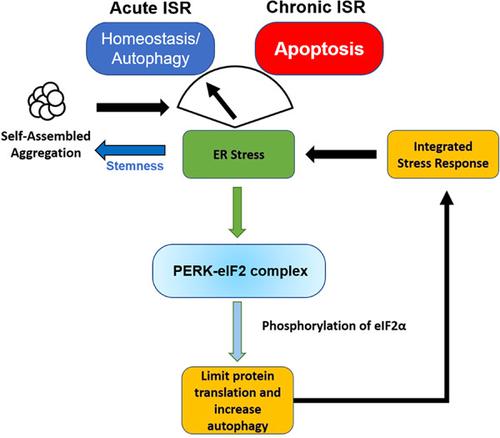当前位置:
X-MOL 学术
›
Biotechnol. Bioeng.
›
论文详情
Our official English website, www.x-mol.net, welcomes your
feedback! (Note: you will need to create a separate account there.)
Aggregation-induced integrated stress response rejuvenates culture-expanded human mesenchymal stem cells.
Biotechnology and Bioengineering ( IF 3.5 ) Pub Date : 2020-06-24 , DOI: 10.1002/bit.27474 Brent M Bijonowski 1, 2 , Qin Fu 1, 3 , Xuegang Yuan 1, 4 , Jerome Irianto 5 , Yan Li 1 , Samuel C Grant 1, 4 , Teng Ma 1
Biotechnology and Bioengineering ( IF 3.5 ) Pub Date : 2020-06-24 , DOI: 10.1002/bit.27474 Brent M Bijonowski 1, 2 , Qin Fu 1, 3 , Xuegang Yuan 1, 4 , Jerome Irianto 5 , Yan Li 1 , Samuel C Grant 1, 4 , Teng Ma 1
Affiliation

|
Protein homeostasis is critical for cellular function, as loss of homeostasis is attributed to aging and the accumulation of unwanted proteins. Human mesenchymal stem cells (MSCs) have shown promising therapeutic potential due to their impressive abilities to secrete inflammatory modulators, angiogenic, and regenerative cytokines. However, there exists the problem of human MSC expansion with compromised therapeutic quality. Duringin vitro expansion, human MSCs are plated on stiff plastics and undergo culture adaptation, which results in aberrant proliferation, shifts in metabolism, and decreased autophagic activity. It has previously been shown that three‐dimensional (3D) aggregation can reverse some of these alterations by heightening autophagy and recovering the metabolic state back to a naïve phenotype. To further understand the proteostasis in human MSC culture, this study investigated the effects of 3D aggregation on the human MSC proteome to determine the specific pathways altered by aggregation. The 3D aggregates and 2D cultures of human MSCs derived from bone marrow (bMSC) and adipose tissue (ASC) were analyzed along with differentiated human dermal fibroblasts (FB). The proteomics analysis showed the elevated eukaryotic initiation factor 2 pathway and the upregulated activity of the integrated stress response (ISR) in 3D aggregates. Specific protein quantification further determined that bMSC and ASC responded to ISR, while FB did not. 3D aggregation significantly increased the ischemic survival of bMSCs and ASCs. Perturbation of ISR with small molecules salubrinal and GSK2606414 resulted in differential responses of bMSC, ASC, and FB. This study indicates that aggregation‐based preconditioning culture holds the potential for improving the therapeutic efficacy of expanded human MSCs via the establishment of ISR and homeostasis.
中文翻译:

聚集诱导的综合应激反应使培养扩增的人类间充质干细胞恢复活力。
蛋白质稳态对于细胞功能至关重要,因为稳态的丧失是由于衰老和不需要的蛋白质的积累。人类间充质干细胞 (MSCs) 具有令人印象深刻的分泌炎症调节剂、血管生成和再生细胞因子的能力,因此显示出有希望的治疗潜力。然而,存在治疗质量受损的人类MSC扩增的问题。在体外扩增过程中,人类 MSC 被铺在坚硬的塑料上并进行培养适应,这会导致异常增殖、代谢变化和自噬活性降低。先前已经表明,三维 (3D) 聚集可以通过增强自噬和将代谢状态恢复到初始表型来逆转其中的一些改变。为了进一步了解人类 MSC 培养物中的蛋白质稳态,本研究调查了 3D 聚集对人类 MSC 蛋白质组的影响,以确定聚集改变的特定途径。分析了源自骨髓 (bMSC) 和脂肪组织 (ASC) 的人类 MSC 的 3D 聚集体和 2D 培养物以及分化的人类真皮成纤维细胞 (FB)。蛋白质组学分析显示真核起始因子 2 通路升高,3D 聚集体中综合应激反应 (ISR) 的活性上调。特定的蛋白质定量进一步确定 bMSC 和 ASC 对 ISR 有反应,而 FB 则没有。3D 聚集显着增加了 bMSCs 和 ASCs 的缺血存活率。用小分子 salubrinal 和 GSK2606414 扰动 ISR 导致 bMSC、ASC 和 FB 的不同反应。
更新日期:2020-06-24
中文翻译:

聚集诱导的综合应激反应使培养扩增的人类间充质干细胞恢复活力。
蛋白质稳态对于细胞功能至关重要,因为稳态的丧失是由于衰老和不需要的蛋白质的积累。人类间充质干细胞 (MSCs) 具有令人印象深刻的分泌炎症调节剂、血管生成和再生细胞因子的能力,因此显示出有希望的治疗潜力。然而,存在治疗质量受损的人类MSC扩增的问题。在体外扩增过程中,人类 MSC 被铺在坚硬的塑料上并进行培养适应,这会导致异常增殖、代谢变化和自噬活性降低。先前已经表明,三维 (3D) 聚集可以通过增强自噬和将代谢状态恢复到初始表型来逆转其中的一些改变。为了进一步了解人类 MSC 培养物中的蛋白质稳态,本研究调查了 3D 聚集对人类 MSC 蛋白质组的影响,以确定聚集改变的特定途径。分析了源自骨髓 (bMSC) 和脂肪组织 (ASC) 的人类 MSC 的 3D 聚集体和 2D 培养物以及分化的人类真皮成纤维细胞 (FB)。蛋白质组学分析显示真核起始因子 2 通路升高,3D 聚集体中综合应激反应 (ISR) 的活性上调。特定的蛋白质定量进一步确定 bMSC 和 ASC 对 ISR 有反应,而 FB 则没有。3D 聚集显着增加了 bMSCs 和 ASCs 的缺血存活率。用小分子 salubrinal 和 GSK2606414 扰动 ISR 导致 bMSC、ASC 和 FB 的不同反应。











































 京公网安备 11010802027423号
京公网安备 11010802027423号